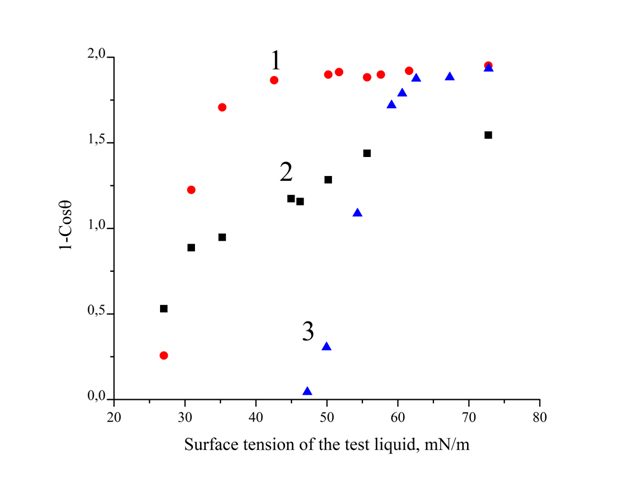Determination of critical surface tension of wetting of textured water-repellent surfaces
DOI:
https://doi.org/10.15587/2706-5448.2023.277936Keywords:
water contact angle, surface tension, water repellent coatings, superhydrophobicity, aluminum, femtosecond laser, silanesAbstract
The object of study is aluminum textured with a femtosecond laser and modified with silanes to reduce surface energy. The presence of a special texture on the surface, such as protrusions or hairs, and the inherently low surface energy of the material allow maximizing the water repellency properties. The determination of the critical wetting surface tension by the Zisman method has a pronounced wetting transition point, but the coordinates of this point cannot be accurately predicted. In this work, the Zisman method is considered as a tool for comparing the effectiveness of modifiers for femtosecond laser-textured surfaces. In this work, periodic structures were created by laser ablation on the surface of aluminum, the surface was modified to achieve the Cassie state when wetted with water, and the critical surface tension of wetting was determined by the Zisman method. As a result, it is shown that the Zisman method in combination with the data on the water contact angle values is an effective tool for characterizing the quality of surface modification of textured samples. It is shown that for textured aluminum surfaces, the most effective modifier is silane, which maintains the Cassie wetting state, with a contact angle increased from 155 to 160°. Paraffin has been shown to be a less effective modifier with an implicit wetting plateau and a transition in the range of 30 to 40 mN/m. It is shown that the textures that have acquired water repellency in the course of spontaneous hydrophobization are very unstable to the action of liquids with reduced polarity, although they have high values of the water contact angle. In practice, the creation of water-repellent coatings on aluminum is a promising substrate due to their widespread use in the aviation, automotive, and energy industries due to their high mechanical strength, lightness, and stability of properties.
References
- Si, Y., Dong, Z., Jiang, L. (2018). Bioinspired Designs of Superhydrophobic and Superhydrophilic Materials. ACS Central Science, 4 (9), 1102–1112. doi: https://doi.org/10.1021/acscentsci.8b00504
- Bhushan, B., Jung, Y. C. (2011). Natural and biomimetic artificial surfaces for superhydrophobicity, self-cleaning, low adhesion, and drag reduction. Progress in Materials Science, 56 (1), 1–108. doi: https://doi.org/10.1016/j.pmatsci.2010.04.003
- Habib, M. A., Wu, S., Fan, Q., Magu, T. O., Yao, X., Lv, J., Wang, J. (2021). Bioinspired in situ repeatable self-recovery of superhydrophobicity by self-reconstructing the hierarchical surface structure. Chemical Communications, 57 (68), 8425–8428. doi: https://doi.org/10.1039/d1cc02974f
- Ellinas, K., Dimitrakellis, P., Sarkiris, P., Gogolides, E. (2021). A Review of Fabrication Methods, Properties and Applications of Superhydrophobic Metals. Processes, 9 (4), 666. doi: https://doi.org/10.3390/pr9040666
- Darmanin, T., Guittard, F. (2015). Superhydrophobic and superoleophobic properties in nature. Materials Today, 18 (5), 273–285. doi: https://doi.org/10.1016/j.mattod.2015.01.001
- Zisman, W. A. (1964). Relation of the Equilibrium Contact Angle to Liquid and Solid Constitution. Contact Angle, Wettability, and Adhesion, 1–51. doi: https://doi.org/10.1021/ba-1964-0043.ch001
- Janovák, L., Dernovics, Á., Mérai, L., Deák, Á., Sebők, D., Csapó, E. et al. (2018). Microstructuration of poly(3-hexylthiophene) leads to bifunctional superhydrophobic and photoreactive surfaces. Chemical Communications, 54 (6), 650–653. doi: https://doi.org/10.1039/c7cc07671a
- Murakami, D., Jinnai, H., Takahara, A. (2014). Wetting Transition from the Cassie–Baxter State to the Wenzel State on Textured Polymer Surfaces. Langmuir, 30 (8), 2061–2067. doi: https://doi.org/10.1021/la4049067
- Myronyuk, O., Baklan, D., Vasilyev, G. S., Rodin, A. M., Vanagas, E. (2022). Wetting Patterns of Liquid-Repellent Femtosecond Laser Textured Aluminum Surfaces. Coatings, 12 (12), 1852. doi: https://doi.org/10.3390/coatings12121852
- Salazar-Hernández, C., Salazar-Hernández, M., Mendoza-Miranda, J. M., Miranda-Avilés, R., Elorza-Rodríguez, E., Carrera-Rodríguez, R., Puy-Alquiza, M. J. (2018). Organic modified silica obtained from DBTL polycondensation catalyst for anticorrosive coating. Journal of Sol-Gel Science and Technology, 87 (2), 299–309. doi: https://doi.org/10.1007/s10971-018-4732-9
- Zhang, B., Zeng, Y., Wang, J., Sun, Y., Zhang, J., Li, Y. (2020). Superamphiphobic aluminum alloy with low sliding angles and acid-alkali liquids repellency. Materials & Design, 188, 108479. doi: https://doi.org/10.1016/j.matdes.2020.108479
- Zhang, Z., Wang, W., Korpacz, A. N., Dufour, C. R., Weiland, Z. J., Lambert, C. R., Timko, M. T. (2019). Binary Liquid Mixture Contact-Angle Measurements for Precise Estimation of Surface Free Energy. Langmuir, 35 (38), 12317–12325. doi: https://doi.org/10.1021/acs.langmuir.9b01252
- Myronyuk, O., Baklan, D., Novoseltsev, A. (2021). Evaluation of the surface energy of solids using two-component mixtures of test liquids. Herald of Khmelnytskyi National University, 297 (3), 81–86. doi: https://doi.org/10.31891/2307-5732-2021-297-3-81-86
- Yong, J., Yang, Q., Hou, X., Chen, F. (2022). Nature-Inspired Superwettability Achieved by Femtosecond Lasers. Ultrafast Science, 2022. doi: https://doi.org/10.34133/2022/9895418
- Liu, W., Cai, M., Luo, X., Chen, C., Pan, R., Zhang, H., Zhong, M. (2019). Wettability transition modes of aluminum surfaces with various micro/nanostructures produced by a femtosecond laser. Journal of Laser Applications, 31 (2), 022503. doi: https://doi.org/10.2351/1.5096076
- Samanta, A., Wang, Q., Shaw, S. K., Ding, H. (2020). Roles of chemistry modification for laser textured metal alloys to achieve extreme surface wetting behaviors. Materials & Design, 192, 108744. doi: https://doi.org/10.1016/j.matdes.2020.108744

Downloads
Published
How to Cite
Issue
Section
License
Copyright (c) 2023 Oleksiy Myronyuk

This work is licensed under a Creative Commons Attribution 4.0 International License.
The consolidation and conditions for the transfer of copyright (identification of authorship) is carried out in the License Agreement. In particular, the authors reserve the right to the authorship of their manuscript and transfer the first publication of this work to the journal under the terms of the Creative Commons CC BY license. At the same time, they have the right to conclude on their own additional agreements concerning the non-exclusive distribution of the work in the form in which it was published by this journal, but provided that the link to the first publication of the article in this journal is preserved.







